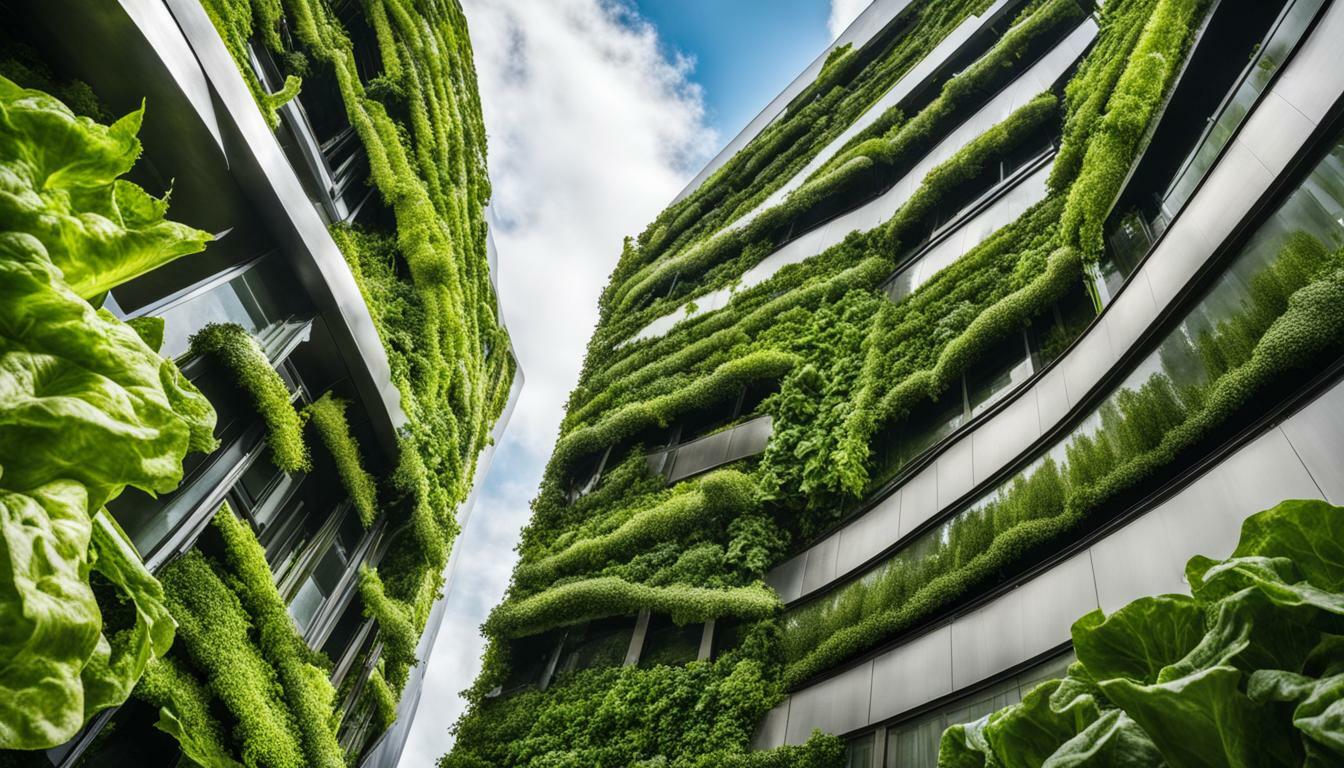The future of urban farming lies in mastering the vertical lettuce garden, a revolutionary approach to growing fresh produce in limited spaces. As urban populations continue to grow and available land diminishes, vertical farming provides a solution to feed the world’s ever-increasing urban population. By utilizing vertical space and advanced farming methods, urban areas can become self-sufficient in food production and reduce the need for long-distance transportation of produce.
Key Takeaways:
- Vertical farming is a sustainable solution to address the challenges of urbanization and limited arable land.
- By growing crops vertically, farmers can maximize space utilization and increase food production in urban environments.
- High-tech farming methods, such as hydroponics and aeroponics, are key components of vertical lettuce gardening.
- Vertical farming projects around the world showcase innovative approaches to urban agriculture.
- Vertical gardens offer a promising outlook for the future of urban farming, providing fresh and locally grown produce.
[Image Description: A vertical lettuce garden, showcasing rows of lush green lettuce plants growing vertically in stacked trays.]
The Importance of Urban Sustainability and Space-Limited Growing
As cities grapple with the challenges of rapid population growth and limited space, urban sustainability becomes a critical consideration, making vertical lettuce gardening a viable solution for cultivating food in space-limited environments. Urban sustainability focuses on creating and maintaining a healthy and livable urban environment, addressing issues such as resource efficiency, waste management, and reducing environmental impact. Space-limited growing refers to the practice of maximizing productivity in urban areas with limited land availability.
Vertical lettuce gardening, also known as vertical farming, offers a sustainable approach to food production in urban areas. By utilizing vertical space, such as the walls of buildings or specially designed structures, farmers can grow crops in a controlled environment. This method allows for year-round cultivation and reduces the need for large tracts of arable land. Additionally, vertical lettuce gardens can be located closer to urban populations, reducing transportation distance and minimizing the carbon footprint associated with food distribution.
One of the key advantages of vertical farming is its efficient use of resources. Through the use of advanced technologies, such as hydroponics or aeroponics, crops can be grown with significantly less water compared to traditional soil-based farming. Vertical farming systems also minimize the need for chemical pesticides and fertilizers, reducing environmental pollution and creating a healthier and more sustainable food production system.
| Benefits of Vertical Lettuce Gardening |
|---|
| Maximizes productivity in limited space |
| Reduces the carbon footprint of food production and distribution |
| Conserves water resources through efficient irrigation systems |
| Minimizes the use of chemical pesticides and fertilizers |
| Provides year-round cultivation opportunities |
Vertical lettuce gardening is not only a sustainable solution for urban food production but also a potential catalyst for the development of sustainable urban ecosystems. By integrating vertical farming into the urban landscape, cities can create green spaces, improve air quality, and enhance the overall livability of urban environments. This integration of agriculture into urban areas can also help reconnect people with their food sources, promoting healthier and more sustainable food consumption habits.
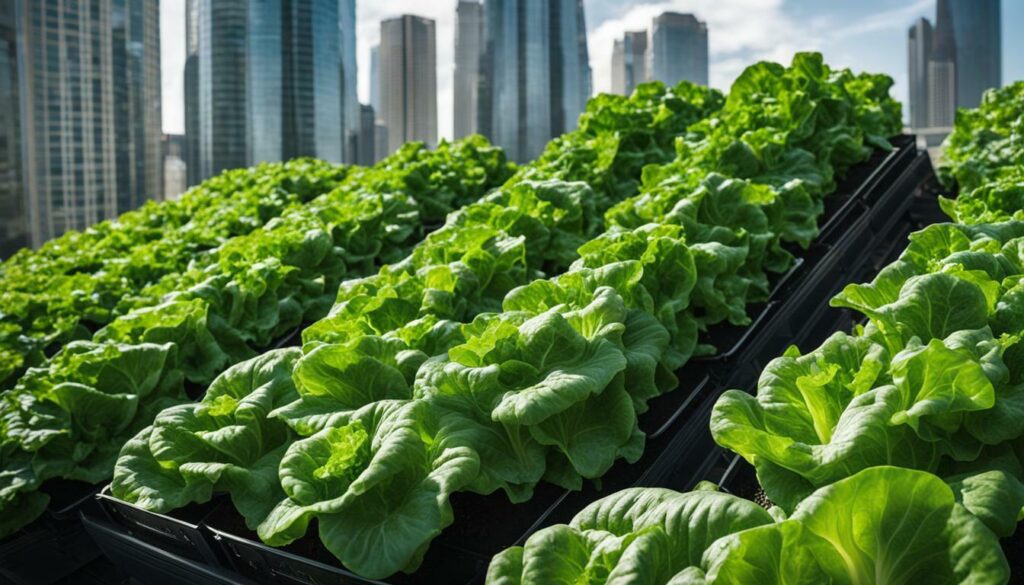
Quote:
“Vertical lettuce gardening offers a sustainable approach to food production in urban areas, addressing the challenges of limited space and rapid population growth.” – Sarah Federman, Office of the Chief Scientist
Understanding the Vertical Farming Concept
Vertical farming is a transformative concept that offers a new approach to urban agriculture, utilizing various forms of cultivation from tall structures to rooftop gardens. This innovative method of farming is driven by the need to address sustainable food production in densely populated cities and the limited availability of arable land. By utilizing vertical space and advanced technologies, vertical farms aim to maximize food production while minimizing the ecological footprint.
The concept of vertical farming has gained significant attention in recent years due to its potential to revolutionize urban agriculture. It offers a solution to the challenges of feeding a growing urban population while reducing the reliance on traditional farming methods that require large land areas. Vertical farms can be categorized into three types: tall structures with multiple levels of growing beds, rooftop farms on existing buildings, and visionary multi-story buildings that are yet to be realized.
Advancements in technology have played a crucial role in the development of vertical farming. High-tech farming methods such as hydroponics, aeroponics, and aquaponics are used to cultivate crops in controlled environments, eliminating the need for soil and reducing water usage. These methods also enable year-round production, independent of external climate conditions. Additionally, the integration of automation and IoT technologies allows for precise monitoring and control of environmental factors, ensuring optimal growing conditions for plants.
Several innovative projects around the world have showcased the potential of vertical farming. These projects range from small-scale urban farms integrated into existing buildings to large-scale vertical farms that aim to feed entire cities. One notable example is the world’s largest vertical farm in Japan, which produces over 10,000 heads of lettuce per day. These projects demonstrate the feasibility and scalability of vertical farming, providing inspiration for future urban agriculture initiatives.
Table 1: Benefits of Vertical Farming
| Benefit | Description |
|---|---|
| Increased Food Production | Vertical farming allows for higher crop yields in a smaller space, maximizing food production potential. |
| Reduced Environmental Impact | By eliminating the need for extensive land use, vertical farming reduces deforestation, water usage, and greenhouse gas emissions. |
| Year-round Production | Controlled indoor environments enable year-round crop cultivation, ensuring a consistent food supply regardless of seasonal fluctuations. |
| Local and Fresh Produce | Vertical farms located in urban areas can provide fresh produce to nearby communities, reducing transportation distances and offering higher-nutrient produce. |
| Water Efficiency | Vertical farming utilizes advanced irrigation systems that minimize water consumption compared to traditional farming methods. |
“Vertical farming offers a promising solution to the challenges of feeding a growing urban population while minimizing the ecological footprint.” – Sarah Federman and Paul M. Zankowski, USDA
In conclusion, vertical farming presents an innovative and sustainable approach to urban agriculture. By utilizing vertical space and advanced technologies, vertical farms aim to address the challenges of limited land availability and environmental sustainability. With the ability to maximize food production, reduce environmental impact, and provide local and fresh produce to urban communities, vertical farming holds great potential for the future of agriculture.
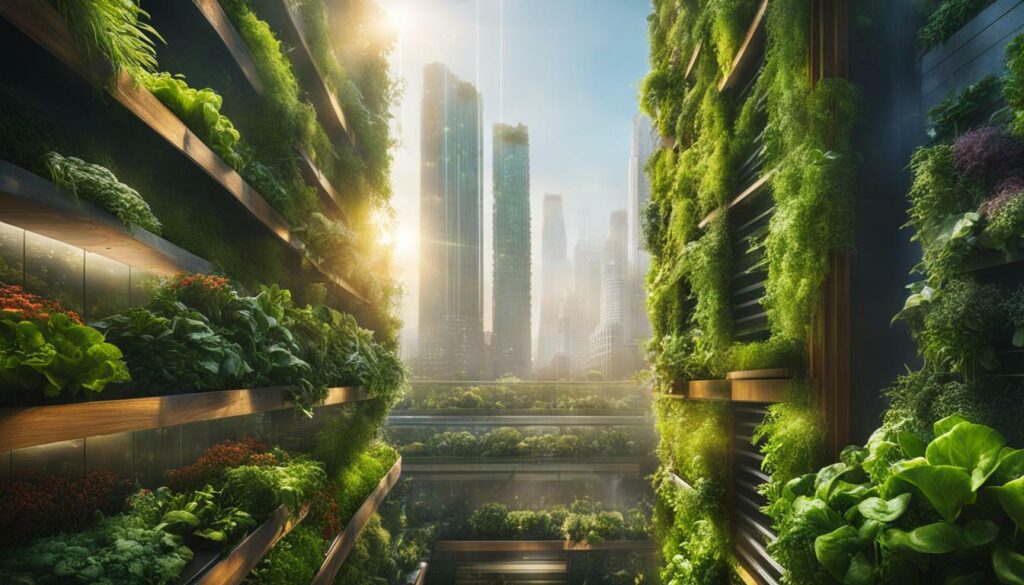
Exploring High-Tech Methods for Vertical Lettuce Gardening
High-tech farming methods, such as robotics and hydroponics, play a crucial role in achieving success in vertical lettuce gardening by enabling precise control over key factors like light, temperature, and nutrient levels. These technological advancements have revolutionized the way we grow crops in urban environments, allowing for year-round production and maximizing space utilization.
Robotics have been widely adopted in vertical lettuce gardens to automate various tasks, including seeding, watering, and harvesting. Robots equipped with advanced sensors and computer vision technology can efficiently navigate through vertical farm structures, ensuring accurate planting and monitoring plant health. By reducing the need for manual labor, robotics not only increase productivity but also minimize human error and optimize resource allocation.
Hydroponics, another high-tech method, involves growing plants without soil by providing nutrient-rich water directly to the plant roots. This technique allows for precise control over the nutrient composition and pH levels, resulting in faster growth and higher yields. Hydroponic systems also conserve water by recycling and reusing it, making them more environmentally friendly compared to traditional soil-based farming.
Vertical farming combines these high-tech methods to create a sustainable and efficient way of growing lettuce in urban areas. By utilizing vertical space and optimizing resource management, vertical farms can produce a significant amount of fresh produce with minimal environmental impact. These innovative farming techniques have the potential to revolutionize food production and address the challenges of feeding a growing urban population.
| Advantages of High-Tech Farming Methods | Examples |
|---|---|
| Precise control over light, temperature, and nutrient levels | – Use of LED lights for optimized plant growth – Climate control systems for maintaining ideal temperature – Nutrient dosing systems for precise feeding |
| Automation of farming tasks | – Robotics for seeding, watering, and harvesting – Automated nutrient monitoring and adjustment systems |
| Optimized resource utilization | – Hydroponic systems for efficient water and nutrient usage – Vertical farming structures for maximum space utilization |
With the integration of high-tech farming methods, vertical lettuce gardening has the potential to revolutionize urban farming and contribute to sustainable food production in a space-limited environment. These advancements not only enhance productivity but also promote resource efficiency and environmental sustainability. As technology continues to evolve, we can expect further innovations in vertical farming, promising a greener and more sustainable future for urban agriculture.
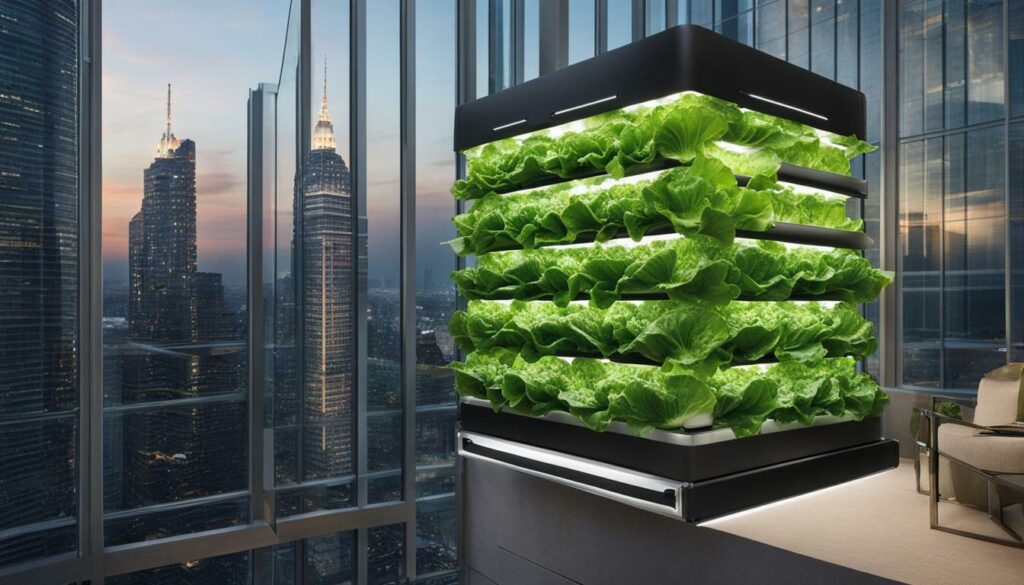
Quote:
“By utilizing high-tech farming methods, vertical lettuce gardening offers a sustainable and efficient solution for urban food production.” – Expert in Vertical Farming
Showcasing Innovative Vertical Lettuce Garden Projects
From repurposed buildings to rooftop gardens, there are numerous innovative projects around the world that showcase the potential of vertical lettuce gardening in urban environments. These projects not only demonstrate the feasibility of growing lettuce vertically but also highlight the benefits of this sustainable farming method.
One notable project is the Plantagon Vertical Greenhouse in Sweden. This state-of-the-art greenhouse is built in a spiral shape, allowing for maximum sunlight exposure and efficient use of space. It utilizes advanced technology, including automated systems for watering and nutrient delivery, to cultivate lettuce and other leafy greens. With its efficient design and sustainable practices, the Plantagon Vertical Greenhouse has become a model for urban agriculture.
Another inspiring project is the Vertical Harvest in Jackson, Wyoming. This pioneering greenhouse is located in a three-story building and utilizes hydroponic systems to grow lettuce and other crops. What sets Vertical Harvest apart is its commitment to employing individuals with disabilities as part of its workforce. This innovative approach not only provides meaningful employment opportunities but also promotes inclusivity and social impact.
Vertical Lettuce Garden Projects Table:
| Project | Location | Description |
|---|---|---|
| Plantagon Vertical Greenhouse | Sweden | A spiral-shaped greenhouse with advanced technology for efficient cultivation of lettuce and other leafy greens. |
| Vertical Harvest | Jackson, Wyoming | A three-story greenhouse that employs individuals with disabilities and utilizes hydroponic systems for lettuce and crop production. |
These are just a few examples of the innovative vertical lettuce garden projects that are revolutionizing urban farming. By embracing vertical farming techniques and leveraging advanced technologies, these projects are paving the way for a more sustainable and efficient future of food production in cities.
Image: 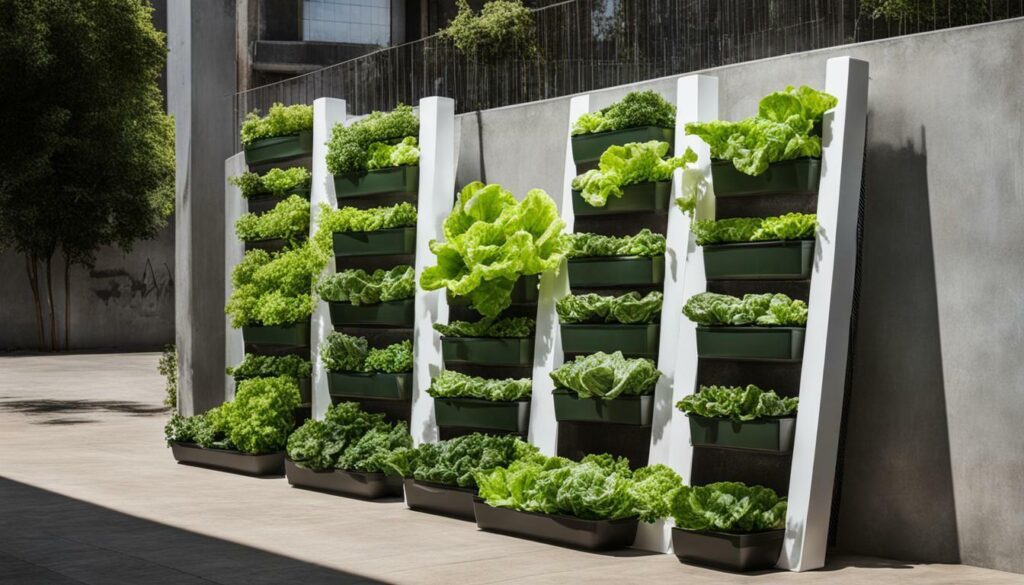
Implications for the Vertical City
Vertical lettuce gardening has far-reaching implications for the vertical city, offering a sustainable solution for urban food production and reducing the need for extensive food transportation. As urban areas continue to experience rapid population growth, the demand for fresh and locally grown produce is increasing. Vertical farming provides a means of cultivating crops in a controlled indoor environment, allowing for year-round production and minimal transportation distances.
This innovative approach to agriculture has the potential to address several sustainability challenges faced by urban areas. By growing food vertically, cities can utilize underutilized spaces such as rooftops and unused buildings, maximizing land efficiency. This not only reduces the need for additional land but also minimizes the negative environmental impacts associated with traditional farming practices, such as soil erosion and pesticide use.
In addition to environmental benefits, vertical farming can also contribute to the overall well-being of urban communities. By providing access to fresh and nutritious produce, vertical lettuce gardens can improve food security and promote healthier diets. Moreover, the proximity of vertical farms to urban populations can enhance food education and awareness, fostering a deeper connection between consumers and the food they consume.
Furthermore, vertical farming offers economic opportunities for urban areas. With the potential for year-round production, these farms can create jobs and stimulate local economies. Additionally, vertical farming technologies and practices can be shared and adopted by other sectors, such as urban design and architecture, promoting innovation and collaboration.
Table 1: Benefits of Vertical Lettuce Gardening
| Benefits | Description |
|---|---|
| Increased food security | By producing food locally, vertical lettuce gardening helps ensure a stable and reliable food supply for urban populations. |
| Reduced environmental impact | Vertical farming minimizes the need for extensive land use, reduces water usage, and eliminates the need for harmful pesticides. |
| Improved nutrition | Access to fresh and nutritious produce directly from vertical farms promotes healthier diets. |
| Economic opportunities | Vertical farming can create jobs and stimulate local economies in urban areas. |
Overall, vertical lettuce gardening holds great potential for transforming urban agriculture and shaping the future of the vertical city. By integrating sustainable farming practices into urban environments, we can create resilient and self-sufficient communities that prioritize food security, environmental stewardship, and economic prosperity.
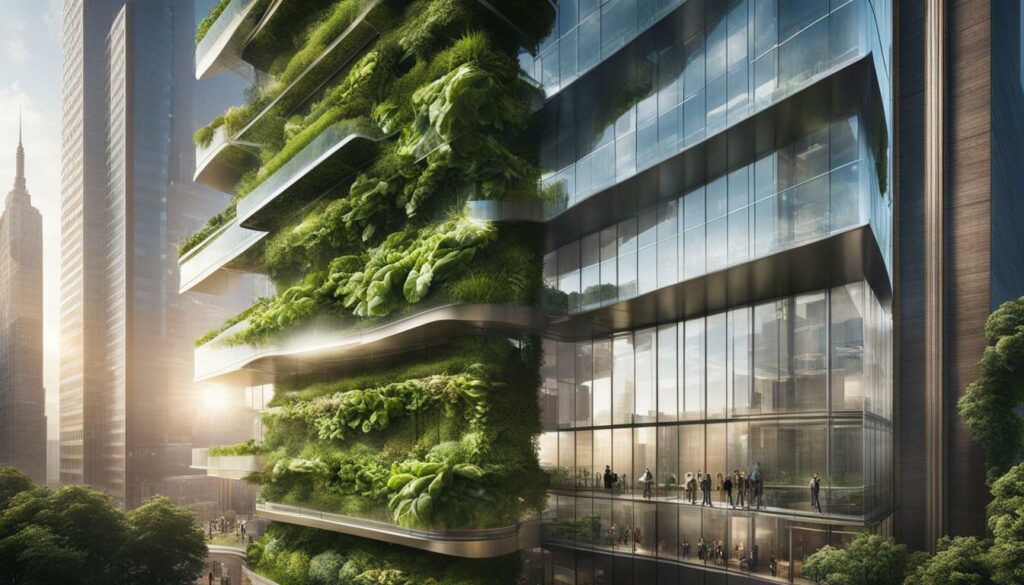
Exploring Lettuce Varieties for Vertical Gardens
When it comes to vertical lettuce gardening, selecting the right lettuce varieties is crucial for successful growth and maximum yield. Lettuce is a versatile and popular leafy green that can thrive in vertical gardens, providing a fresh and nutritious addition to your urban farm. Here are some popular lettuce varieties that are well-suited for vertical gardening:
1. Butterhead Lettuce
Butterhead lettuce is known for its tender leaves and mild flavor. It forms loose heads and has a soft texture, making it a popular choice for salads and sandwiches. Some popular butterhead lettuce varieties include Bibb, Boston, and Buttercrunch.
2. Romaine Lettuce
Romaine lettuce, also known as Cos lettuce, has elongated heads with crisp leaves and a slightly bitter taste. It is commonly used in Caesar salads and adds a satisfying crunch to dishes. Popular romaine lettuce varieties include Parris Island, Little Gem, and Freckles.
3. Loose-leaf Lettuce
Loose-leaf lettuce varieties are known for their loose, non-heading growth habit. They have tender leaves that come in a range of colors, including green, red, and speckled. Loose-leaf lettuce is versatile and can be harvested leaf by leaf, allowing for continuous production. Popular loose-leaf lettuce varieties include Red Salad Bowl, Green Oakleaf, and Lollo Rossa.
When choosing lettuce varieties for your vertical garden, consider factors such as taste preferences, growth habits, and available space. Experiment with different varieties to find the ones that thrive in your vertical gardening setup. Remember to provide adequate lighting, moisture, and nutrients to ensure healthy growth.
| Lettuce Variety | Leaf Color | Growth Habit | Taste |
|---|---|---|---|
| Bibb | Green | Compact | Mild |
| Boston | Green | Compact | Mild |
| Buttercrunch | Green | Compact | Mild |
| Parris Island | Green | Long and upright | Crisp |
| Little Gem | Green | Compact | Crisp |
| Freckles | Green with red speckles | Long and upright | Crisp |
| Red Salad Bowl | Red | Loose | Mild |
| Green Oakleaf | Green | Loose | Mild |
| Lollo Rossa | Red | Loose | Mild |
Table: Popular lettuce varieties for vertical gardens.
By incorporating a variety of lettuce types in your vertical garden, you can enjoy a diverse range of flavors, textures, and colors. Whether you prefer the delicate leaves of butterhead lettuce, the crunchiness of romaine lettuce, or the vibrant hues of loose-leaf lettuce, there is a lettuce variety that will thrive in your vertical gardening setup.
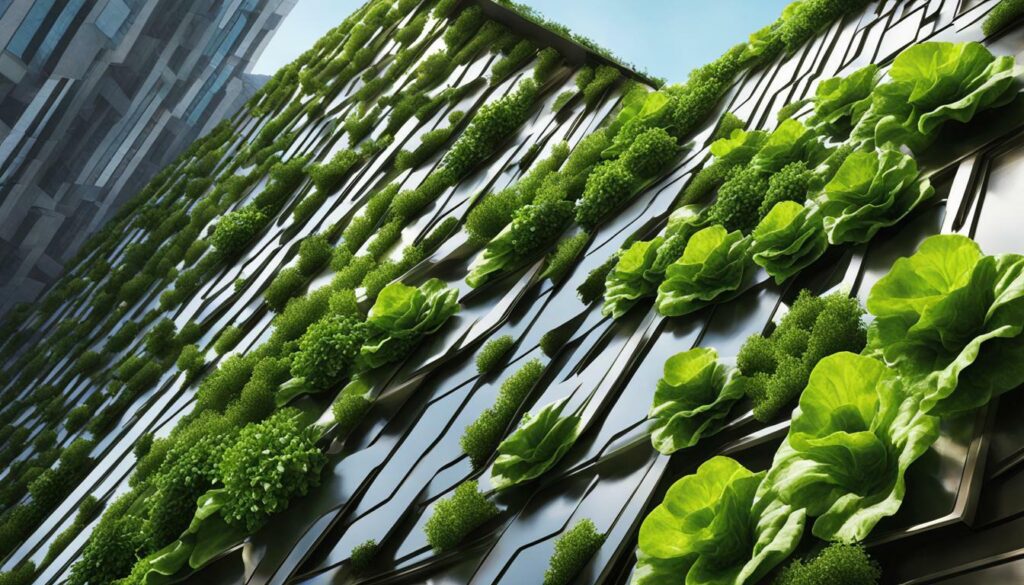
Essential Tips for Vertical Lettuce Gardening
To ensure the success of your vertical lettuce garden, it’s important to follow some essential tips and techniques for proper lighting, spacing, watering, and pest control. These tips will help you maximize your yield and create a thriving vertical garden.
1. Lighting
Light plays a crucial role in the growth of lettuce plants. When setting up your vertical garden, make sure to place it in a location that receives ample sunlight. If natural sunlight is limited, consider using artificial lighting, such as LED grow lights, to provide the necessary light spectrum for plant growth. Position the lights so that they cover all areas of the garden evenly.
2. Spacing
Proper spacing between lettuce plants is essential for their healthy growth. Be sure to follow the recommended spacing guidelines for the specific lettuce variety you are growing. Overcrowding can lead to competition for nutrients and limited airflow, increasing the risk of diseases. Regularly monitor the growth of your plants and thin them out if needed.
Consider using vertical gardening systems that allow for efficient use of space. These systems often provide individual compartments for each plant, ensuring optimal spacing and maximizing the number of plants you can grow in a limited area.
3. Watering
Consistent and adequate watering is crucial for vertical lettuce gardens. The vertical orientation of the garden can affect water distribution, so it’s important to pay attention to the moisture levels of the plants.
Consider using a drip irrigation system or self-watering containers to ensure plants receive a consistent water supply. Monitor the moisture levels regularly and adjust watering accordingly, avoiding both under and over-watering. Be mindful of drainage to prevent waterlogging, which can lead to root rot.
4. Pest Control
Vertical gardens can be susceptible to pests, just like traditional gardens. Regularly inspect your plants for signs of pests, such as aphids or caterpillars, and take appropriate measures to control them. Consider using natural pest control methods, such as introducing beneficial insects or using organic insecticides.
Maintaining good garden hygiene, such as removing dead leaves and regularly cleaning the garden structure, can also help prevent pest infestations. Rotate crops and avoid planting the same lettuce variety in the same location year after year to minimize the risk of recurring pest problems.
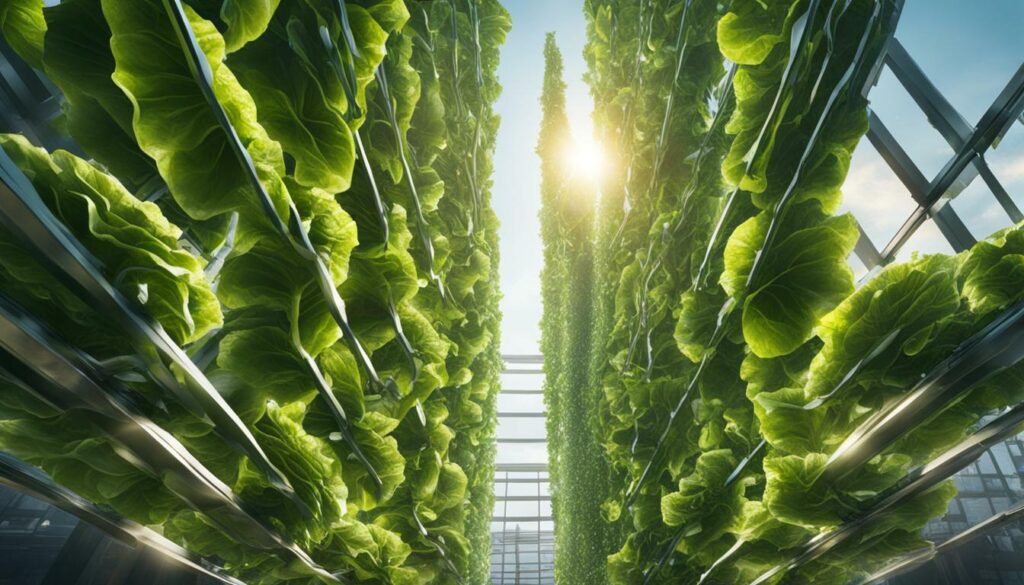
A well-maintained vertical lettuce garden can provide a bountiful harvest and contribute to a sustainable and efficient food production system. By following these essential tips and techniques, you can create a thriving vertical garden and enjoy the benefits of homegrown lettuce all year round.
| Tips for Vertical Lettuce Gardening |
|---|
| Ensure proper lighting by placing your garden in a sunny location or using LED grow lights. |
| Follow recommended spacing guidelines to prevent overcrowding and ensure healthy growth. |
| Provide consistent and adequate watering, using drip irrigation or self-watering containers. |
| Monitor plants for pests and take appropriate measures for control, such as using natural pest control methods. |
Embracing Indoor Vertical Lettuce Gardens
Indoor vertical lettuce gardens offer numerous benefits, allowing for year-round cultivation, protection from external factors, and precise control over growing conditions. As urbanization continues to increase and land resources become limited, indoor vertical gardening provides a solution to meet the rising demands for fresh produce in urban areas.
Vertical farming technology enables farmers to grow crops in a controlled environment, optimizing factors such as light, temperature, and water. This precise control allows for efficient resource utilization and maximizes crop productivity. By growing lettuce vertically indoors, farmers can overcome the limitations of traditional agriculture and grow crops in urban environments with limited space.
One of the advantages of indoor vertical lettuce gardens is the ability to cultivate crops year-round. By creating an artificial environment, farmers can bypass seasonal limitations and supply fresh produce consistently. This not only ensures a continuous food supply but also reduces the need for long transportation distances, thereby minimizing carbon emissions and supporting local food systems.
In addition to sustainability benefits, indoor vertical lettuce gardens offer increased food safety. By eliminating the use of pesticides and reducing the risk of contamination from external factors, such as animal waste, indoor farming provides a clean and controlled environment for crop growth. This enhanced food safety is crucial, especially in the context of increasing foodborne illnesses and the importance of public health.
Benefits of Indoor Vertical Lettuce Gardens:
- Year-round cultivation
- Optimized resource utilization
- Reduced carbon emissions
- Enhanced food safety
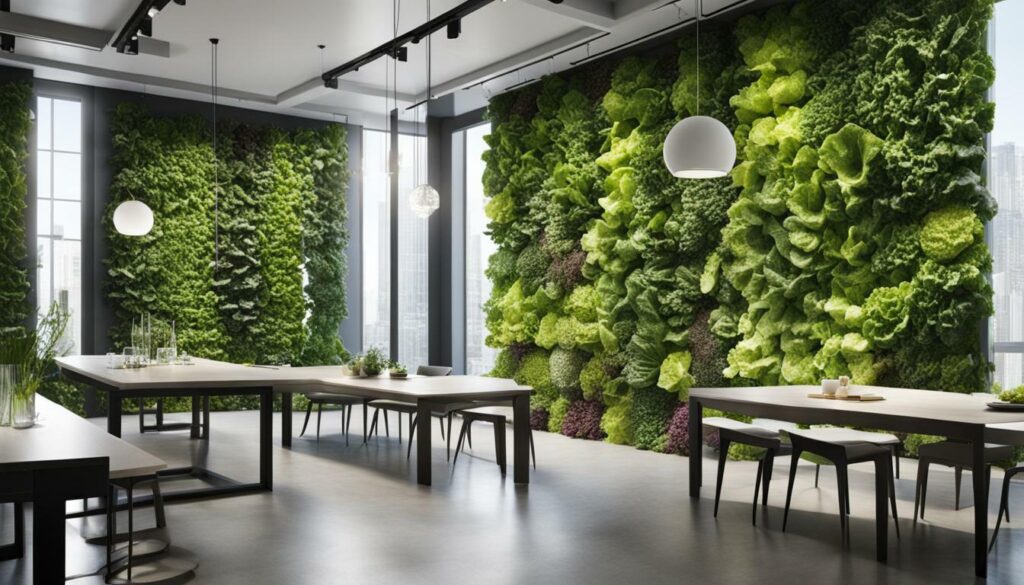
| Lettuce Varieties | Description |
|---|---|
| Butterhead | A soft and tender lettuce with loose leaves and a buttery flavor. |
| Romaine | A longer, crisp lettuce with sturdy leaves and a slightly bitter taste. |
| Iceberg | A dense lettuce with a mild flavor and crunchy texture. |
“Indoor vertical lettuce gardens provide a sustainable solution for urban areas to meet the growing demand for fresh produce while minimizing environmental impact.” – Sarah Federman, AAAS Science and Technology Policy Fellow
DIY Vertical Lettuce Garden Ideas
Get creative with DIY vertical lettuce garden ideas, using innovative materials, designs, and techniques to bring your own vertical garden to life. Vertical gardening is a practical and space-saving solution for urban dwellers who may have limited access to traditional gardening spaces. With a bit of creativity and some basic materials, you can create a vibrant and productive vertical lettuce garden right in your own home.
One popular DIY idea for vertical lettuce gardens is to use recycled materials, such as old pallets or wooden crates, to create a multi-tiered garden structure. Simply stack the pallets or crates vertically and secure them together. Each level can be filled with soil and planted with lettuce seedlings. This not only adds an interesting aesthetic to your garden but also makes it easy to harvest your lettuce at the perfect height.
Another creative idea is to use hanging planters or wall-mounted planters to create a vertical lettuce garden. These can be easily attached to walls, fences, or balconies, allowing you to make the most of your vertical space. You can mix and match different varieties of lettuce for a colorful and diverse display. Hang the planters at different heights to create a visually appealing arrangement.
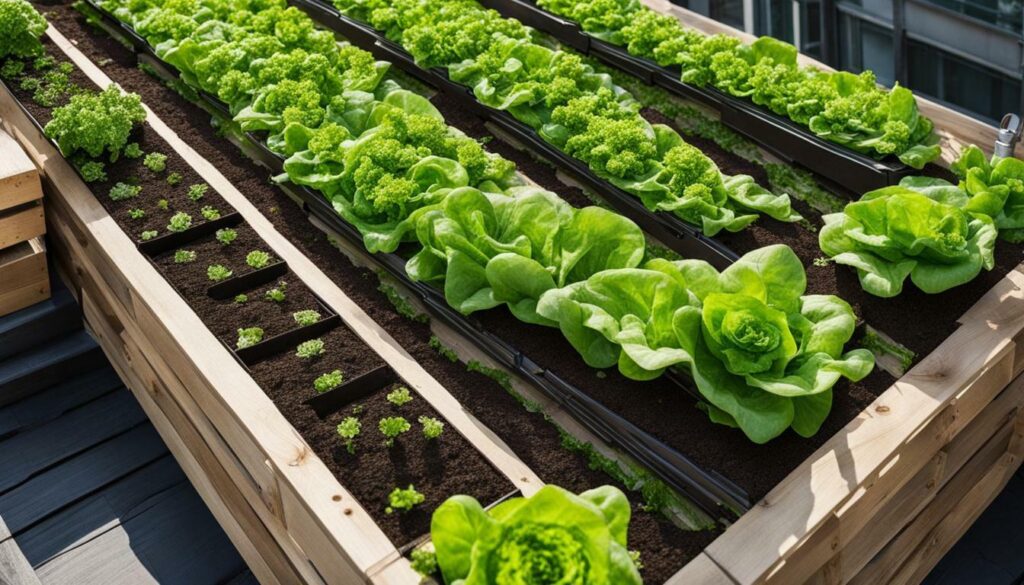
For those who prefer a more organized and compact garden, consider using a vertical gardening system. These systems typically consist of a series of stacked containers that allow you to grow multiple plants in a small footprint. Some systems are even equipped with built-in irrigation systems to ensure your lettuce receives the right amount of water. These can be a great option for busy individuals who want to enjoy the benefits of gardening without the hassle of daily maintenance.
When planning your DIY vertical lettuce garden, don’t forget to consider the specific needs of lettuce plants. Lettuce prefers cool temperatures and moist soil, so be sure to place your garden in a shaded area and water it regularly. Additionally, choose varieties of lettuce that are well-suited for vertical growing, such as loose-leaf or butterhead lettuce.
Benefits of DIY Vertical Lettuce Gardens:
- Maximize limited space in urban environments
- Grow fresh, organic lettuce at home
- Create an aesthetically pleasing and unique garden display
- Reduce reliance on store-bought produce
- Enjoy the convenience of harvesting lettuce at your desired height
With these DIY vertical lettuce garden ideas, you can embrace the concept of urban farming and become a self-sufficient gardener, even in the smallest of spaces. Start experimenting with different materials, designs, and techniques to create your own vertical garden oasis.
The Future of Urban Farming: A Promising Outlook
The future of urban farming looks promising, with vertical lettuce gardening playing a key role in sustainable food production, enhanced food security, and resilient urban landscapes. As cities around the world grapple with rapid population growth and limited arable land, vertical farming offers a potential solution to the challenge of transporting large amounts of food to serve dense populations. By utilizing vertical space in buildings and rooftops, urban farmers can cultivate crops year-round, reducing the need for transportation and minimizing the carbon footprint associated with conventional agricultural practices.
Vertical farming involves the construction of tall structures with multiple levels of growing beds, often using artificial lights to supplement sunlight. This innovative approach to farming has gained traction in both new and repurposed buildings, including warehouses and rooftops. The concept of vertical farming is not new, with historical examples dating back to the Hanging Gardens of Babylon in 600 BC. However, recent advancements in technology, such as robotics, aeroponics, aquaponics, and hydroponics, have fueled the growth of vertical farming projects around the world.
One of the key advantages of vertical farming is its ability to produce crops closer to urban populations, reducing the distance food travels and ensuring fresher and higher-nutrient produce for consumers. Furthermore, vertical farming significantly reduces water usage and runoff compared to traditional agriculture methods, addressing the sustainability challenges associated with water scarcity. Additionally, vertical farming offers opportunities for new business models and collaborations between various stakeholders, including environmental organizations, for-profit ventures, and governments seeking to enhance food security.
While the concept of vertical farming holds immense promise, there are still challenges to overcome, such as high initial costs, energy consumption, and potential limitations in crop diversity. However, ongoing research and innovation are driving advancements in the field, with countries worldwide exploring vertical farming as a means to create sustainable and resilient urban environments.
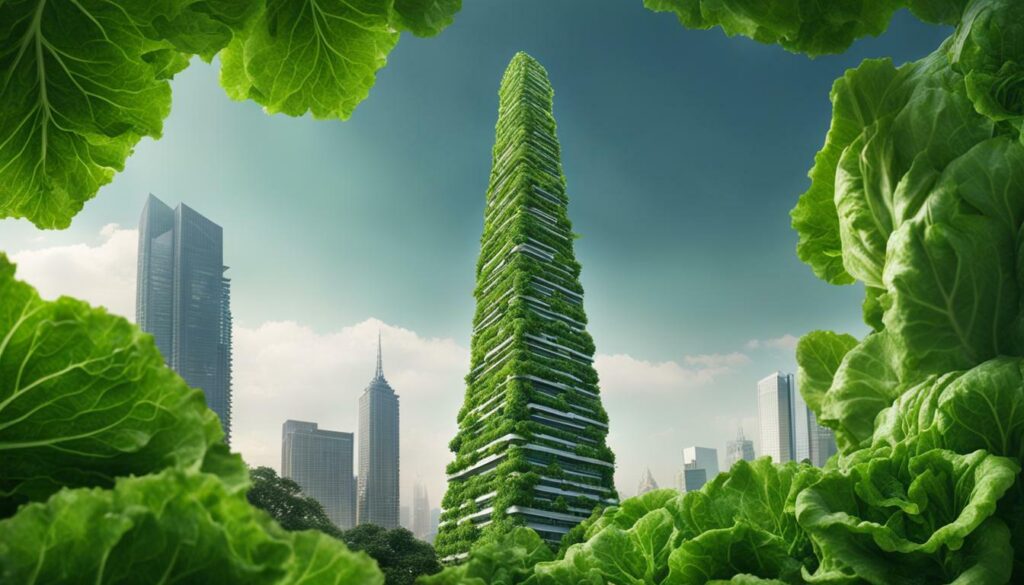
In summary, vertical lettuce gardening presents a promising outlook for the future of urban farming. With its potential to address critical issues such as food security and environmental sustainability, vertical farming is positioned to revolutionize the way we produce and consume food in urban areas. Continued investment in research, technology, and collaboration will further propel the development of vertical farming and pave the way for a more sustainable and resilient future.
Conclusion
Vertical lettuce gardening offers a sustainable and innovative approach to urban farming, with the potential to revolutionize food production and meet the growing demands of urban populations. As cities continue to experience rapid population growth and limited space for traditional agriculture, vertical farming provides a viable solution to ensure a local and fresh food supply.
Through the use of advanced high-tech farming methods, vertical lettuce gardens can be cultivated in vertical structures such as tall buildings, rooftops, and repurposed warehouses. These methods include hydroponics, aeroponics, and aquaponics, which optimize resource efficiency by using less water and reducing the need for pesticides and herbicides.
There are already several innovative vertical lettuce garden projects around the world, showcasing the potential of this farming concept. These projects demonstrate the versatility of vertical farming, from small-scale urban gardens to visionary multi-story buildings. The integration of technology, such as robotics and IoT systems, further enhances the efficiency and productivity of vertical lettuce gardens.
The implications of vertical farming extend beyond food production. Embracing this concept can contribute to urban sustainability by reducing food miles, carbon emissions, and water usage. It also promotes food security and resilience by creating a local and decentralized food supply chain.
When it comes to lettuce varieties for vertical gardens, there are numerous options to choose from, including leaf lettuce, romaine lettuce, and butterhead lettuce. Each variety has its unique characteristics and growth requirements, making it essential to select the appropriate lettuce type for vertical gardening.
For successful vertical lettuce gardening, it is important to follow essential tips and best practices. These include providing adequate lighting, proper nutrient management, regular monitoring of plant health, and optimizing space utilization. With the right techniques and care, vertical lettuce gardens can thrive in indoor settings as well.
DIY vertical lettuce garden ideas offer an exciting opportunity for individuals to create their own vertical farming systems. From using repurposed materials to designing vertical structures, DIY projects empower urban dwellers to participate in sustainable food production and contribute to their local communities.
The future of urban farming looks promising with the continued development of vertical lettuce gardening. This approach not only addresses the challenges of limited space and resource constraints but also promotes sustainable and resilient food systems. By embracing vertical farming, cities can take a significant step towards achieving urban sustainability and ensuring a local and fresh food supply for their growing populations.
How Can Vertical Lettuce Gardens Benefit Urban Farming and Transforming Spaces?
Vertical lettuce gardens can transform your space with lettuce grow by providing a sustainable solution for urban farming. These gardens allow for efficient use of space, reduce water consumption, and provide fresh produce in urban areas. By utilizing vertical space, urban environments can benefit from increased greenery and access to locally grown produce.
FAQ
Q: What is vertical farming?
A: Vertical farming is a farming method that involves growing crops in vertically stacked layers, such as in a multilevel building or a vertical tower. It allows for food production in urban environments with limited space and can be done using various high-tech farming techniques.
Q: What are the driving forces for building vertical farms?
A: The driving forces for building vertical farms include the need to address food security in rapidly growing urban populations, the desire to reduce the environmental impact of traditional agriculture, the advancements in technology that enable controlled growing environments, and the potential to produce food closer to urban consumption areas.
Q: What are the high-tech farming methods used in vertical farming?
A: High-tech farming methods used in vertical farming include hydroponics, which is growing plants in nutrient-rich water without soil; aeroponics, which is growing plants in an air or mist environment with nutrient solutions; and aquaponics, which is the integration of aquaculture and hydroponics. These methods optimize resource use and enable year-round crop production.
Q: Can you provide some examples of vertical farming projects?
A: Some examples of vertical farming projects include small-scale urban farms in repurposed buildings and warehouses, rooftop gardens on commercial and residential structures, and visionary multi-story vertical farms that have yet to be built. These projects are found in various countries around the world.
Q: What are the implications for the vertical city?
A: Vertical farming has implications for the vertical city by offering a solution to food security challenges in densely populated areas. It can reduce the need for long-distance transportation of food, decrease water usage and runoff, and provide fresher and higher-nutrient produce to urban populations. Vertical farming can contribute to the sustainability and resilience of vertical cities.

